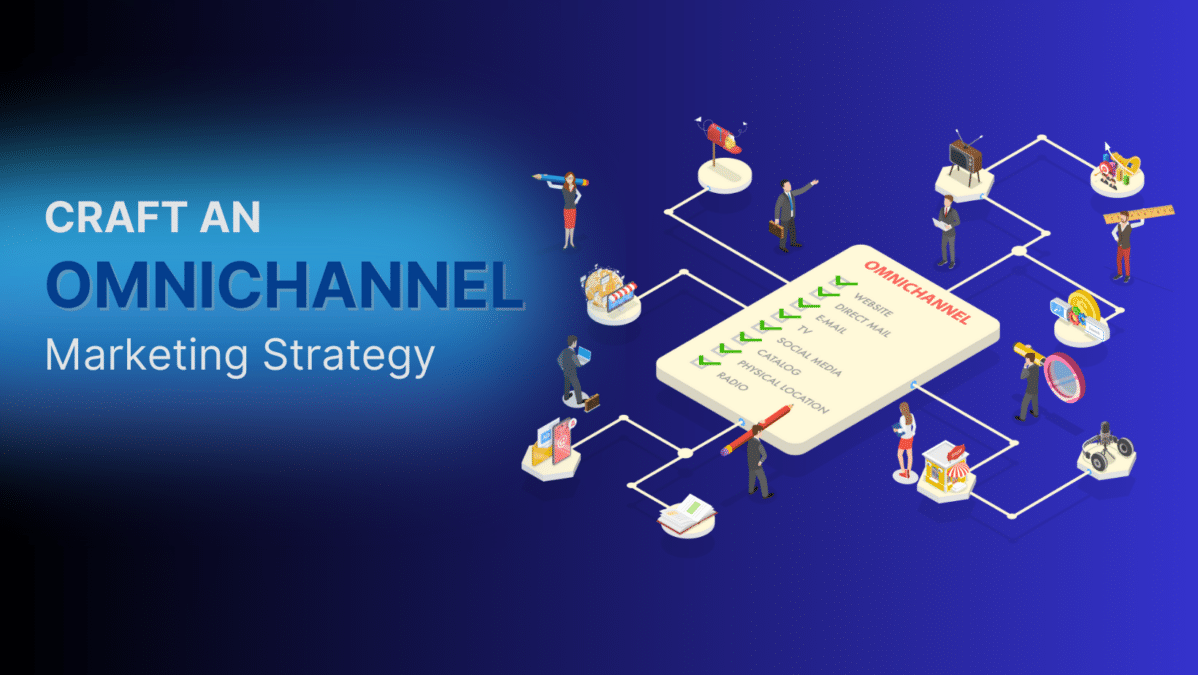
How to Choose the Right Font for Your Marketing
November 15, 2023
6 Social Media Algorithms Marketers Need to Know About
November 29, 2023How To Exploit Omnichannel Marketing For Better Reach
Discover the essence of effective modern marketing. Understand why an omnichannel approach is vital for genuine brand success.
Many believe a stunning website or catchy ad alone can skyrocket success. Think again! While each plays a role, thriving in today’s digital space requires a multi-faceted approach. It’s like expecting a plant to bloom with only sunlight but no water. Without integrating key components like social media, listings, and consistent content, even the most striking ads can fizzle out. Let’s debunk the myth of the “single solution” and shed light on the power of omnichannel marketing.
What is Omnichannel Marketing?
Omnichannel marketing refers to a fully integrated and cohesive approach to marketing that ensures a seamless and unified consumer experience across all channels and touchpoints. Instead of operating in silos, all communication channels, both online (e.g., websites, social media, emails) and offline (e.g., physical stores, call centers), are integrated and consistent.
The goal of omnichannel marketing is to provide a seamless and consistent brand message and user experience no matter how, where, or when a consumer interacts with a brand. This strategy considers the individual’s journey through all touchpoints, enabling more personalized and contextually relevant interactions, thereby enhancing the overall customer experience.
The Myth of the Standalone Website
Many business owners fall for the myth that simply launching a website is the golden ticket to online success. However, a website, on its own, isn’t a “set it and forget it” solution. Just as a store needs regular inventory updates and aesthetics refreshing, a website requires ongoing care.
Consistent website optimization is essential. As user preferences evolve and technology advances, ensuring your site aligns with the latest best practices is crucial. It’s about remaining user-friendly, loading quickly, and staying compatible with the myriad of devices users might employ.
And let’s not overlook content. Stale, outdated information can deter potential customers, while fresh, relevant content can boost engagement and conversions.
Moreover, as search engine algorithms update, failing to tweak and refine your site can push you down in rankings. This lowers your visibility, making it harder for customers to find you. In this bustling digital market, a static website is akin to a whisper in a hurricane. Regular enhancements, paired with a cohesive online strategy encompassing social media, listings, and more, turn that whisper into a clear, resonant voice, drawing customers in.
Ads Without a Strong Online Footprint: A Recipe for Distrust
When users encounter ads from companies with a skimpy online presence, skepticism often emerges. In a digital-first age, a strong online footprint validates a brand, assuring potential customers of its authenticity and credibility. Without this validation, many users conclude that the company may be fly-by-night or, worse, an outright scam.
Take the case of Brand X, which launched an extensive ad campaign but had no social media activity and a barely functional website. Users who clicked through the ads were met with outdated information and broken links. As a result, warnings about Brand X being a potential scam spread rapidly online.
Similarly, despite offering quality products, Brand Y faced backlash due to their sporadic online postings and lack of engagement. Both brands underline the risk: ads without a robust online backdrop can harm more than they help.
Consistent Social Media Presence: Building Trust and Brand Recognition
A consistent social media presence is pivotal for any brand aiming to establish legitimacy. Regular posting keeps a brand top-of-mind and sends a message: “We’re active, engaged, and here to stay.” This consistency subtly reinforces trust among followers and potential customers, distinguishing a brand from less active competitors.
Beyond mere visibility, consistent posting fosters deeper audience engagement. Engaging content sparks conversations, feedback, and shares. These interactions are golden opportunities for brands to get closer to their followers, understand their needs, and tailor their offerings accordingly. Moreover, every like, comment, or share amplifies brand reach, introducing the brand to new potential followers or customers.
But it’s not just about quantity; the quality of interactions matters immensely. Responding to comments, addressing concerns, or simply thanking followers for their input can cultivate a loyal brand community. In the vast sea of social media, where fleeting attention is the norm, brands that consistently show up and engage meaningfully set themselves apart, fostering both trust and recognition.
Importance of Listings and Reviews
Being listed on respected sites is essential as consumers frequently turn to the internet for initial information. These listings not only elevate a brand’s visibility but also bestow a mark of credibility. It signals to potential customers that a business is established and recognized in its industry or community.
Equally significant are reviews. For many consumers, reviews serve as the digital equivalent of personal recommendations. Before making a purchase or choosing a service, individuals often seek out others’ experiences to gauge reliability and quality. Positive feedback can significantly influence purchasing decisions, while negative reviews can offer businesses insights into areas for improvement.
In short, a business’s online reputation, shaped significantly by reviews, plays a pivotal role in a consumer’s decision-making process.
The Interconnectedness of Marketing Channels
Marketing is far from a one-channel affair. Instead, it’s a symphony of interconnected platforms, each crucial in reaching and engaging potential customers.
Consider online ads, for instance. While they capture attention effectively, their real power is amplified when they lead viewers to a polished, updated website. The ads spark interest, but it’s the website that provides depth, answering questions and establishing brand credibility.
Similarly, the relationship between social media and content is reciprocal. Social platforms are fantastic for broadcasting new blog posts or website updates, ensuring your audience remains informed about your latest offerings or insights. On the flip side, high-quality content on your site gives social media followers valuable information to engage with, share, and discuss.
But it’s not just about individual interactions. Integrated marketing campaigns — those that leverage multiple channels in a coordinated fashion — hold immense value. They offer consistent messaging across platforms, making it easier for potential customers to recognize and remember your brand. Each platform reinforces the others, creating a holistic experience that’s more memorable than isolated interactions.
In essence, while each marketing channel can function independently, their combined force truly drives success. An omnichannel approach ensures potential customers receive a seamless and consistent brand experience, no matter where they engage with your business.
Common Misconceptions and Pitfalls in Marketing
In marketing, there are numerous misconceptions that can derail even the best-laid plans. A prominent myth is the age-old belief, “If I build a website, they will come.” Just creating a website, no matter how visually appealing, doesn’t guarantee a flood of visitors. Active promotion, SEO optimization, and continuous content updates drive traffic.
Another widespread misconception is that having a social media profile on just one platform is enough. While it’s true that any online presence is better than none, each platform caters to a different demographic and serves various purposes. Restricting your brand to a single platform may limit your reach and potential.
This brings us to the danger of over-relying on a single marketing channel. Many businesses, lured by the appeal of quick returns, may pour all their resources into paid ads, neglecting organic search and social media engagement. While ads can offer a temporary boost, solely relying on them can be unsustainable in the long run. On the other hand, an overemphasis on organic content while neglecting paid opportunities might slow down potential growth.
Furthermore, ignoring user reviews and feedback is a pitfall. Reviews significantly influence potential customers. Avoiding or, worse, deleting negative reviews instead of addressing them can harm your brand’s reputation.
Overall, a balanced, multi-channel approach is key. Understanding and avoiding these common misconceptions and pitfalls will ensure a more holistic and effective marketing strategy.
Crafting an Omnichannel Marketing Strategy
Designing a robust marketing strategy requires an integrated approach that leverages the strengths of omnichannel. Here’s how to weave them together seamlessly:
- Assess and Align: Before jumping in, assess each channel’s unique strengths and audiences. Align your content to suit each platform’s character while serving your broader marketing objectives.
- Consistent Branding: As you spread your wings across various channels, maintain uniformity in visual elements like colors, logos, and graphics. This visual consistency helps fortify brand recognition. If a visitor moves from your Instagram page to your website, they should feel like they’re in the same space.
- Unified Messaging: While the tone and format might differ across channels, the core message should remain unwavering. For instance, if you’re launching a product and emphasizing its sustainability on one platform, this theme should echo across others, even if the presentation varies.
- Leverage Cross-Promotion: Use one channel to amplify the content of another. Share your latest blog post on Facebook, or use Instagram to tease an upcoming webinar. This interconnectedness not only boosts engagement but also guides audiences through various facets of your brand.
- Regular Reviews: Periodically review analytics across channels. Recognize patterns, see which tactics resonate, and refine your strategy accordingly. This iterative approach ensures your strategy remains dynamic and responsive to audience preferences.
- Engage and Adapt: Engage with your audience across platforms. Respond to comments, seek feedback, and be open to course corrections. An adaptable strategy that listens and evolves based on audience input will always remain relevant.
A comprehensive marketing strategy is not about being everywhere but being impactful wherever you are. With consistent branding, unified messaging, and a keen understanding of each channel’s strengths, brands can craft a resonant and effective multi-platform presence.
The Power of an Omnichannel Marketing Approach
These days, a piecemeal approach to marketing simply won’t suffice. The most impactful brands operate with a comprehensive, unified strategy, ensuring every touchpoint with customers resonates and aligns with their overarching brand message.
Why? Because consumers today interact with brands in more ways than ever before. They might discover you on social media, research your website, read reviews, and finally, see an ad before making a purchase. At each stage, a disjointed message or mismatched branding can sow seeds of doubt.
Businesses must continuously assess their marketing strategies. If you’re only making waves in one pool, it’s time to expand. Test new platforms, experiment with different content types, and always remember the bigger picture. This doesn’t mean jumping on every new trend but strategically broadening your reach for maximum impact.
Yet, achieving this seamless integration across multiple platforms is no easy feat. It requires expertise, dedication, and a keen understanding of modern marketing dynamics. For brands looking for consistency, expertise, and a bespoke strategy, partnering with a marketing agency like Advent Trinity Marketing Agency becomes invaluable. Let the experts craft an omnichannel strategy so your brand shines consistently across all channels.




